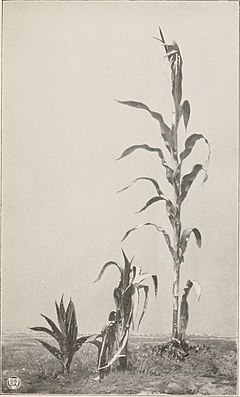forked branches nearly the same size in diameter. arising from a common junction and lacking a normal branch union; may have included bark.
This article needs additional citations for verification. (February 2018) (Learn how and when to remove this template message) |
Dominance, in genetics, is the phenomenon in which one variant (allele) of a gene on a chromosome masks or overrides the effect of a different variant of the same gene on the other copy of the chromosome. The first variant is termed dominant and the second recessive. This state of having two different variants of the same gene on each chromosome is originally caused by a mutation in one of the genes, either new (de novo) or inherited. The terms autosomal dominant or autosomal recessive are used to describe gene variants on non-sex chromosomes (autosomes) and their associated traits, while those on sex chromosomes (allosomes) are termed X-linked dominant, X-linked recessive or Y-linked, and these show a very different inheritance and presentation pattern to autosomal traits which depends on the sex of the individual (see Sex linkage). Additionally, there are other forms of dominance such as incomplete dominance, in which a gene variant has a partial effect compared to when it is present on both chromosomes, and co-dominance, in which different variants on each chromosome both show their associated traits.
Dominance is not inherent to an allele or its traits (phenotype). It is a strictly relative effect between two alleles of a given gene of any function; one allele can be dominant over a second allele of the same gene, recessive to a third and co-dominant with a fourth. Additionally, one allele may be dominant for one trait but not others.
Often, the dominant allele codes for a functional protein whereas the recessive allele does not. Hence, many autosomal recessive conditions are the result of lack of a functioning protein, for example an enzyme. On the other hand, many autosomal dominant conditions result in the presence of a diseased form of a critical protein or simply not enough expressivity of the critical protein.
Dominance is a key concept in Mendelian inheritance and classical genetics. Letters and Punnett squares are used to demonstrate the principles of dominance in teaching, and the use of upper case letters for dominant alleles and lower case letters for recessive alleles is a widely followed convention. A classic example of dominance is the inheritance of seed shape in peas. Peas may be round, associated with allele R, or wrinkled, associated with allele r. In this case, three combinations of alleles (genotypes) are possible: RR, Rr, and rr. The RR (homozygous) individuals have round peas, and the rr (homozygous) individuals have wrinkled peas. In Rr (heterozygous) individuals, the R allele masks the presence of the r allele, so these individuals also have round peas. Thus, allele R is dominant over allele r, and allele r is recessive to allele R.
Dominance differs from epistasis, the phenomenon of an allele of one gene masking the effect of alleles of a different gene.

